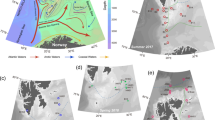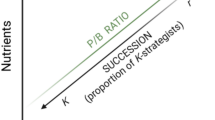Abstract
We measured seasonal variations in microzooplankton grazing in Long Island Sound (LIS) and San Francisco Bay (SFB). There was consistent evidence of nutrient limitation in LIS, but not SFB. We found higher chlorophyll a concentrations in LIS compared with SFB. In spite of differences in phytoplankton, there were no differences in microzooplankton abundance (summer: LIS, 12.4 ± 1.8 × 103 indiv. L−1; SFB, 14.1 ± 3.0 × 103 indiv. L−1), biomass (summer: LIS, 30.4 ± 5.0 μg C L−1; SFB, 26.3 ± 5.9 μg C L−1), or grazing rates (summer: LIS, 0.66 ± 0.19 day−1; SFB, 0.65 ± 0.18 day−1) between the two estuaries. In common with many other investigators, we found many instances of saturated as well as insignificant grazing. We suggest that saturation in some cases may result from high particle loads in turbid estuarine systems and that insignificant grazing may result from extreme saturation of the grazing response due to the need to process non-food particles.







Similar content being viewed by others
References
Alpine, A.E., and J.E. Cloern. 1988. Phytoplankton growth rates in a light-limited environment, San Francisco Bay. Marine Ecology Progress Series 44: 167–173.
Alpine, A.E., and J.E. Cloern. 1992. Trophic interactions and direct physical effects control phytoplankton biomass and production in an estuary. Limnology and Oceanography 37: 946–955.
Andersen, T., A.K.L. Schartau, and E. Paasche. 1991. Quantifying external and internal nitrogen and phosphorus pools, as well as nitrogen and phosphorus supplied through remineralization, in coastal marine plankton by means of a dilution technique. Marine Ecology Progress Series 69: 67–80.
Anderson, T.H., and G.T. Taylor. 2001. Nutrient pulses, plankton blooms, and seasonal hypoxia in western Long Island Sound. Estuaries 24: 228–243.
Bouley, P., and W.J. Kimmerer. 2006. Ecology of a highly abundant, introduced cyclopoid copepod in a temperate estuary. Marine Ecology Progress Series 324: 219–228.
Calbet, A., and M.R. Landry. 2004. Phytoplankton growth, microzooplankton grazing, and carbon cycling in marine systems. Limnology and Oceanography 49: 51–57.
Calbet, A., and E. Saiz. 2005. The ciliate-copepod link in marine ecosystems. Aquatic Microbial Ecology 38: 157–167.
Capriulo, G.M., G. Smith, R. Troy, G.H. Wikfors, J. Pellet, and C. Yarish. 2002. The planktonic food web structure of a temperate zone estuary, and its alteration due to eutrophication. Hydrobiologia 475: 263–333.
Cloern, J.E. 2007. Habitat connectivity and ecosystem productivity: Implications from a simple model. The American Naturalist 169: E21–E33.
Conover, S.A.M. 1956. Oceanography of Long Island Sound, 1952–1954. IV. Phytoplankton. Bulletin of the Bingham Oceanographic Collection 15: 62–112.
Crocker, K., and C. Gotschalk. 1997. Short communication. A simple seawater-powered plankton wheel. Journal of Plankton Research 19: 155–158.
Deevey, G.B. 1956. Oceanography of Long Island sound, 1952–1954, V. Zooplankton. Bulletin of the Bingham Oceanographic Collection 15: 113–155.
DeJonge, V.N., W. Boynton, C.F. D’Elia, R. Elmgren, and B.L. Welsh. 1994. Responses to developments in eutrophication in four different North Atlantic estuarine systems. In Changes in fluxes in estuaries, ed. K.R. Dyer and R.J. Orth, 179–196. Fredensborg: Olsen & Olsen.
Dolan, J.R., C.L. Gallegos, and A. Moigis. 2000. Dilution effects on microzooplankton in dilution grazing experiments. Marine Ecology Progress Series 200: 127–139.
Dugdale, R.C., F.P. Wilkerson, V.E. Hogue, and A. Marchi. 2007. The role of ammonium and nitrate in spring bloom development in San Francisco Bay. Estuarine, Coastal and Shelf Science 73: 17–29.
Falkowski, P.G., and C.D. Wirick. 1981. A simulation model of the effects of vertical mixing on primary productivity. Marine Biology 65: 69–75.
Fenchel, T. 1988. Marine plankton food chains. Annual Review of Ecology and Systematics 19(no. 1): 19–38.
Foxgrover, A., R.E. Smith, and B.E. Jaffe. 2007. Suisun Bay and Delta bathymetry. http://sfbay.wr.usgs.gov/sediment/delta/conclusions.html. Accessed 9 September 2007.
Froneman, P.W., and C.D. McQuaid. 1997. Preliminary investigation of the ecological role of microzooplankton in the Kariega Estuary, South Africa. Estuarine, Coastal and Shelf Science 45: 689–695.
Gallegos, C.L. 1989. Microzooplankton grazing on phytoplankton in the Rhode River, Maryland: Nonlinear feeding kinetics. Marine Ecology Progress Series 57: 23–33.
Gallegos, C.L., and T.E. Jordan. 1997. Seasonal progression of factors limiting phytoplankton pigment biomass in the Rhode River estuary, Maryland (USA). I. Controls on phytoplankton growth. Marine Ecology Progress Series 161: 185–198.
Gay, P., and J. O’Donnell. 2009. Comparison of the salinity structure of the Chesapeake Bay, the Delaware Bay, and Long Island Sound using a linearly tapered advection-dispersion model. Estuaries and Coasts 32: 68–87.
Gay, P.S., J. O’Donnell, and C.A. Edwards. 2004. Exchange between Long Island Sound and adjacent waters. Journal of Geophysical Research 109: C06017. doi:10.1029/2004JC002319.
Goebel, N.L., J.N. Kremer, and C.A. Edwards. 2006. Primary production in Long Island Sound. Estuaries and Coasts 29: 232–245.
Hu, H.L., H.M. Chen, N.P. Nikolaidis, D.R. Miller, and X. Yang. 1998. Estimation of nutrient atmospheric deposition to Long Island Sound. Water, Air, and Soil Pollution 105: 521–538.
Jeong, H.J., J.H. Shim, C.W. Lee, J.S. Kim, and S.M. Koh. 1999. Growth and grazing rates of the marine planktonic ciliate Strombidinopsis sp. on red-tide and toxic dinoflagellates. The Journal of Eukaryotic Microbiology 46: 69–76.
Jeong, H.J., J.H. Ha, Y.D. Yoo, J.Y. Park, J.H. Kim, N.S. Kang, et al. 2007. Feeding by the Pfiesteria-like heterotrophic dinoflagellate Luciella masanensis. The Journal of Eukaryotic Microbiology 54: 231–241.
Juhl, A.R., and M.C. Murrell. 2005. Interactions between nutrients, phytoplankton growth, and microzooplankton grazing in a Gulf of Mexico estuary. Aquatic Microbial Ecology 38: 147–156.
Kamiyama, T. 1994. The impact of grazing by microzooplankton in northern Hiroshima Bay, the Seto Inland Sea, Japan. Marine Biology 119: 77–88.
Kimmerer, W.J. 2004. Open water processes of the San Francisco Estuary: From physical forcing to biological responses. San Francisco Estuary and Watershed Science 2(1): 1.
Landry, M.R. 1993. Estimating rates of growth and grazing mortality of phytoplankton by the dilution method. In Handbook of methods in aquatic microbial ecology, ed. P.F. Kemp, B.F. Sherr, E.B. Sherr, and J.J. Cole, 715–722. Ann Arbor: Lewis Publishers.
Landry, M.R., and R.P. Hassett. 1982. Estimating the grazing impact of marine microzooplankton. Marine Biology 67: 283–288.
Lehrter, J.C., J.R. Pennock, and G.B. McManus. 1999. Microzooplankton grazing and nitrogen excretion across a surface estuarine-coastal interface. Estuaries 22: 113–125.
Lessard, E.J. 1991. The trophic role of heterotrophic dinoflagellates in diverse marine environments. Marine Microbial Food Webs 5: 49–58.
Malone, T.C. 1971a. The relative importance of nannoplankton and netplankton as primary producers in tropical oceanic and neritic phytoplankton communities. Limnology and Oceanography 16: 633–639.
Malone, T.C. 1971b. The relative importance of nannoplankton and netplankton as primary producers in the California current system. Fishery Bulletin 69: 799–820.
Mauchline, J. 1998. The biology of calanoid copepods. New York: Academic.
McManus, G.B. 1995. Phytoplankton abundance and pigment changes during simulated in situ dilution experiments in estuarine waters: possible artifacts caused by algal light adaptation. Journal of Plankton Research 17: 1705–1716.
McManus, G.B., and M.C. Ederington-Cantrell. 1992. Phytoplankton pigments and growth rates, and microzooplankton grazing in a large temperate estuary. Marine Ecology Progress Series 87: 77–85.
McManus, G.B., B.A. Costas, H.G. Dam, R.M. Lopes, S.A. Gaeta, S.M. Susini, and C.H. Rosetta. 2007. Microzooplankton grazing of phytoplankton in a tropical upwelling region. Hydrobiologia 575: 69–81.
Menden-Deuer, S., E.J. Lessard, J. Satterberg, and D. Grunbaum. 2005. Growth rates and starvation survival of three species of the pallium-feeding, thecate dinoflagellate genus Protoperidinium. Aquatic Microbial Ecology 41: 145–152.
Murrell, M.C., and J.T. Hollibaugh. 1998. Microzooplankton grazing in northern San Francisco Bay measured by the dilution method. Aquatic Microbial Ecology 15: 53–63.
Murrell, M.C., R.S. Stanley, E.M. Lores, G.T. DiDonato, and D.A. Flemer. 2002. Linkage between microzooplankton grazing and phytoplankton growth in a Gulf of Mexico estuary. Estuaries 25: 19–29.
Parsons, T.R., Y. Maita, and C.M. Lalli. 1984. A manual of chemical and biological methods for seawater analysis. New York: Pergamon.
Paterson, H.L., B. Knott, A.J. Koslow, and A.M. Waite. 2008. The grazing impact of microzooplankton off south west Western Australia: as measured by the dilution technique. Journal of Plankton Research 30: 379.
Putland, J.N., and R.L. Iverson. 2007. Microzooplankton: major herbivores in an estuarine planktonic food web. Marine Ecology Progress Series 345: 63–73.
Putt, M., and D.K. Stoecker. 1989. An experimentally determined carbon: Volume ratio for marine “oligotrichous” ciliates from estuarine and coastal waters. Limnology and Oceanography 34: 1097–1103.
Redden, A.M., B.G. Sanderson, and D. Rissik. 2002. Extending the analysis of the dilution method to obtain the phytoplankton concentration at which microzooplankton grazing becomes saturated. Marine Ecology Progress Series 226: 27–33.
Strom, S.L., and K.A. Fredrickson. 2008. Intense stratification leads to phytoplankton nutrient limitation and reduced microzooplankton grazing in the southeastern Bering Sea. Deep-Sea Research II 55: 1761–1774.
Strom, S.L., M.B. Olson, E.L. Macri, and C.W. Mordy. 2007. Cross-shelf gradients in phytoplankton community structure, nutrient utilization, and growth rate in the coastal Gulf of Alaska. Marine Ecology Progress Series 328: 75–92.
Thompson, J.K. 2000. Two stories of phytoplankton control by bivalves in San Francisco Bay: The importance of spatial and temporal distribution of bivalves. Journal of Shellfish Research 19: 612.
Uye, S.I. 1991. Temperature-dependent development and growth of the planktonic copepod Paracalanus sp. in the laboratory. Bulletin of Plankton Society, Japan. Special Volume: 627–636.
Verity, P.G. 1991. Measurement and simulation of prey uptake by marine planktonic ciliates fed plastidic and aplastidic nanoplankton. Limnology and Oceanography 36: 729–750.
Verity, P.G., and C. Langdon. 1984. Relationships between lorica volume, carbon, nitrogen, and ATP content of tintinnids in Narragansett Bay. Journal of Plankton Research 6: 859–868.
Welsh, B.L., and F.C. Eller. 1991. Mechanisms controlling summertime oxygen depletion in western Long Island Sound. Estuaries and Coasts 14: 265–278.
Wilkerson, F.P., R.C. Dugdale, V.E. Hogue, and A. Marchi. 2006. Phytoplankton blooms and nitrogen productivity in San Francisco Bay. Estuaries and Coasts 29: 401–416.
Acknowledgments
We thank colleagues at the Romberg Tiburon Center/San Francisco State University for hosting us during the SFB experiments, especially Wim Kimmerer, Anne Slaughter, and Toni Ignoffo. Don Schoener helped with experiments in both locations, and Gary Wikfors of the NOAA Milford Laboratory kindly provided access to the flow cytometer. We also thank Penny Vlahos for sharing unpublished nutrient data from Long Island Sound. Funding was provided by the CALFED Bay-Delta Science Program (award SCI-05-C107), by the NOAA Coastal Services Center (award NA04NOS4730256), and by the University of Connecticut.
Author information
Authors and Affiliations
Corresponding author
Rights and permissions
About this article
Cite this article
York, J.K., Costas, B.A. & McManus, G.B. Microzooplankton Grazing in Green Water—Results from Two Contrasting Estuaries. Estuaries and Coasts 34, 373–385 (2011). https://doi.org/10.1007/s12237-010-9336-8
Received:
Revised:
Accepted:
Published:
Issue Date:
DOI: https://doi.org/10.1007/s12237-010-9336-8




